Chicago’s 2020 Tre Bicchieri, one of the wine trade’s favorite events, was filled with more exciting wines than ever including sparkling Gavi, ultra-lux Franciacorta, and old classics next to up-and-coming wine regions.
Gambero Rosso, the self-described “world authority on Italian food, wine, and travel”, sponsors the Tre Bicchieri Tour which is the world’s premier Italian wine showcase. This year, nearly 200 Italian wineries poured wines awarded the coveted “Tre Bicchieri” (“three glass”) designation, which fewer than 1% Italian wines achieve.
Standouts this year started with the less-seen but always rewarding Abruzzo and Marche regions. 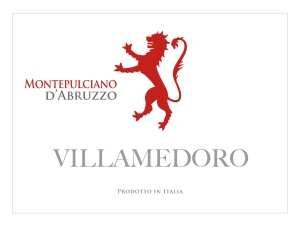 Located on Italy’s Adriatic side, both regions feature the Montepulciano grape which produces wines with robust tannins and deep color. The 2018 Villa Medoro Montepulciano d’Abruzzo was an earthier style than the fruitier 2017 Montecappone Rosso Piceno (a blend of 80% Montepulciano and 20% Sangiovese) yet both of these wines demonstrate the complexity that Montepulciano can achieve near the Adriatic coast.
Located on Italy’s Adriatic side, both regions feature the Montepulciano grape which produces wines with robust tannins and deep color. The 2018 Villa Medoro Montepulciano d’Abruzzo was an earthier style than the fruitier 2017 Montecappone Rosso Piceno (a blend of 80% Montepulciano and 20% Sangiovese) yet both of these wines demonstrate the complexity that Montepulciano can achieve near the Adriatic coast.
Montecappone also featured its 2016 Utopia Castelli di Jesi Verdicchio Riserva which was a wonderful expression of the classic Italian white grape, Verdicchio. Aged 18 months on its lees with an additional 12 months in bottle, this wine tasted of herbs, lime, and chamomile with a waxy finish from the time on lees. The wine is named after Thomas More’s book, “Utopia”, written in 1516. At Montecappone, Utopia means “the way to perfection: walk, study, work, and live to produce excellent quality wines”.
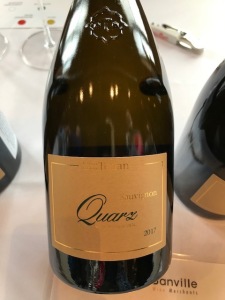 Moving to the Alto Adige region, Cantina Terlano’s 2017 A.A. Terlano Saugivnon Quarz was scintillating with nervy acid, dominant gooseberry and grapefruit, and wet stone minerality on the long textural finish. Made with gentle whole cluster pressing and aged 9 months on lees in 50% large wood barrels and 50% stainless steel, this wine is a remarkably unique Sauvignon Blanc from northern Italy. Its name comes from the fine inclusions of quartz in Terlano’s volcanic porphyry rock soil.
Moving to the Alto Adige region, Cantina Terlano’s 2017 A.A. Terlano Saugivnon Quarz was scintillating with nervy acid, dominant gooseberry and grapefruit, and wet stone minerality on the long textural finish. Made with gentle whole cluster pressing and aged 9 months on lees in 50% large wood barrels and 50% stainless steel, this wine is a remarkably unique Sauvignon Blanc from northern Italy. Its name comes from the fine inclusions of quartz in Terlano’s volcanic porphyry rock soil.
I never miss the chance to try Barolo and was thrilled to find the 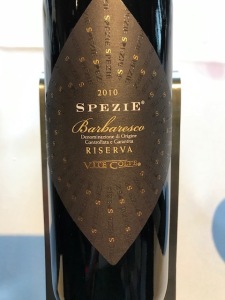 2015 Vite Colte Barolo del Commune di Barolo Essenze. Tasting of black fruit, rose petals, and tobacco, chewy tannins and vibrant acid drove this wine along to a haunting balsamic-laced finish. The 2010 Vite Colte Barbaresco Spezie Rieserva was also alluring with its violet, currant, and clove notes. Two years aging in small oak barrels and one year in bottle melded both of these wines into ethereal delights for Nebbiolo lovers. Both wines are produced only in the best vintage years so snap them up if you can find them.
2015 Vite Colte Barolo del Commune di Barolo Essenze. Tasting of black fruit, rose petals, and tobacco, chewy tannins and vibrant acid drove this wine along to a haunting balsamic-laced finish. The 2010 Vite Colte Barbaresco Spezie Rieserva was also alluring with its violet, currant, and clove notes. Two years aging in small oak barrels and one year in bottle melded both of these wines into ethereal delights for Nebbiolo lovers. Both wines are produced only in the best vintage years so snap them up if you can find them.
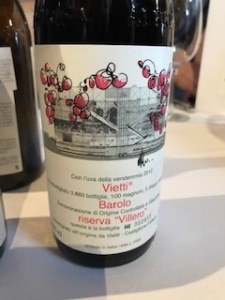 Following along the Barolo path, I was early enough to the tasting to try the 2012 Vietti Barolo Villero Riserva. This wine was only produced 13 times out of the last 38 years and is a tiny production of 3860 bottles. Made from a south/southwest-facing vineyard near Castiglione Falletto, the Vietti portion of the Villero vineyard is barely one hectare in size. Clay soils and 43-year old vines contributed to cascading notes of crushed violet, dried red cherry, and iron nestled among dense tannins and refreshing acidity. Aged in large oak casks and unfiltered before bottling, this wine was pure unadulterated bliss. For the points lovers, this wine achieved 100 points in 2007 and 2009 and 99 points in 2010.
Following along the Barolo path, I was early enough to the tasting to try the 2012 Vietti Barolo Villero Riserva. This wine was only produced 13 times out of the last 38 years and is a tiny production of 3860 bottles. Made from a south/southwest-facing vineyard near Castiglione Falletto, the Vietti portion of the Villero vineyard is barely one hectare in size. Clay soils and 43-year old vines contributed to cascading notes of crushed violet, dried red cherry, and iron nestled among dense tannins and refreshing acidity. Aged in large oak casks and unfiltered before bottling, this wine was pure unadulterated bliss. For the points lovers, this wine achieved 100 points in 2007 and 2009 and 99 points in 2010.
Sicily continues to produce fascinating wines and I made sure to check in on some of my favorite producers there, some of whom one of my travel groups got to visit last year. Cantine Nicosia was once again outstanding with its mineral-driven 2013 Etna Rosso Monte Gorna Riserva and 2017 Rosso Vulkà. The Vulkà is a blend of 80% Nerello Mascalese and 20% Nerello Cappuccio from volcanic soils and an altitude of 650-750 meters. Intended for early drinking, this fruity and energetic wine was aged in tonneaux and 6 months in bottle. 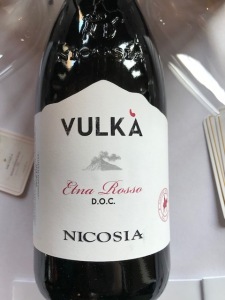
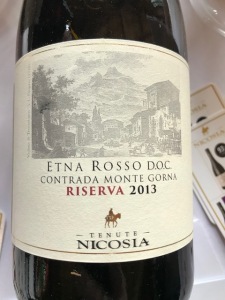 The Monte Gorna Riserva comes from an extinguished crater by the same name which is located at 750 meters and filled with lava terraces. Grapes are hand-picked and selected for this elegant and regal wine. Predominantly Nerello Mascalese at 90% with 10% Nerello Cappuccio, this wine fermented on its skins for 3 weeks followed by 24 months in French oak barrels and 12 months in bottle. Careful attention to every detail produced this beauty tasting of licorice, dried red cherry, freshly-tilled earth, and tobacco flavors.
The Monte Gorna Riserva comes from an extinguished crater by the same name which is located at 750 meters and filled with lava terraces. Grapes are hand-picked and selected for this elegant and regal wine. Predominantly Nerello Mascalese at 90% with 10% Nerello Cappuccio, this wine fermented on its skins for 3 weeks followed by 24 months in French oak barrels and 12 months in bottle. Careful attention to every detail produced this beauty tasting of licorice, dried red cherry, freshly-tilled earth, and tobacco flavors.
In addition, Cantine Nicosia had their lively 2019 Sicilia Fondo Filara Frappato, an organic and vegan wine bursting with red raspberry, blueberries, and purple flower notes. Frappato is an ancient Sicilian grape and this wine was part of their limited production Fondo Filara series.
 Also from Sicily, Cottanera had a stunning expression of Carricante in their 2018 Etna Bianco. A complex nose of lemon, jasmine, and cedar culminated in a full-bodied wine with mouth-coating waxiness from 6 months of lees aging.
Also from Sicily, Cottanera had a stunning expression of Carricante in their 2018 Etna Bianco. A complex nose of lemon, jasmine, and cedar culminated in a full-bodied wine with mouth-coating waxiness from 6 months of lees aging.
Tenuta di Arceno is a Tuscan winery owned by Jackson Family 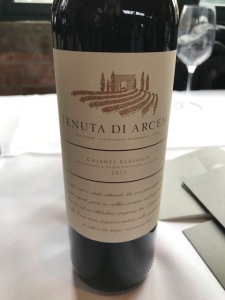 Wines in Napa. Jackson Family has acquired several wineries around the world and having been fortunate enough to visit several, I always come away impressed with their selections. Tenuta di Arceno had a terrific offering of a Chianti Classico and two Super Tuscans, one Merlot-dominant (2013 Valadorna) and one Cabernet Franc-dominant (2013 Arcanum). Both were delicious but I favored the Valadorna which was a blend of 74% Merlot, 12% Cabernet Sauvignon, 23% Cabernet Franc, 1% Petit Verdot. Full of ripe plum, blueberry, and sweet spice, this wine showcased Merlot at its finest.
Wines in Napa. Jackson Family has acquired several wineries around the world and having been fortunate enough to visit several, I always come away impressed with their selections. Tenuta di Arceno had a terrific offering of a Chianti Classico and two Super Tuscans, one Merlot-dominant (2013 Valadorna) and one Cabernet Franc-dominant (2013 Arcanum). Both were delicious but I favored the Valadorna which was a blend of 74% Merlot, 12% Cabernet Sauvignon, 23% Cabernet Franc, 1% Petit Verdot. Full of ripe plum, blueberry, and sweet spice, this wine showcased Merlot at its finest.
 Wrapping up, the Franciacorta offerings were off-the-chart impressive. Two producers I tried were Ferghettina and Ricci Curbastro, both amazingly rich and complex in style. Ferghettina has a unique square bottle which they created to increase the contact surface area between the wine and the yeast. This results in enhanced aromatics in the wine as it ages.
Wrapping up, the Franciacorta offerings were off-the-chart impressive. Two producers I tried were Ferghettina and Ricci Curbastro, both amazingly rich and complex in style. Ferghettina has a unique square bottle which they created to increase the contact surface area between the wine and the yeast. This results in enhanced aromatics in the wine as it ages.
The 2012 Ferghettina Franciacorta Pas Dosè Riserva 33 is composed from 33% of the base wine from 3 of their other wines – the Saten, Milledì and Extra Brut. This results in a wine made from grapes from 40 different vineyards located in 8 municipalities of Franciacorta. Made of 100% Chardonnay and aged 80 months on lees with zero dosage, this elegant yet muscular wine exuded dried bread and candied fruit notes with a commanding finish of toast and almond.
Do not miss the chance to try Le Mesma’s 2013 Gavi Spumante Metodo Classico if you can find it. Floral and fruity with electric acidity, this wine had all of Gavi’s “yellow” profile (flowers, peach, and lemon) with a structured nutty and brioche finish from its classic Champagne method production.
I wish I had a couple more days at this grand event, there were so many special wines and regions to experience but I’m grateful that I got to try what I did. Tre Bicchieri is always a first-rate and truly compelling experience that makes its attendees fall in love with wine all over again.

Vite Colte Vineyard
